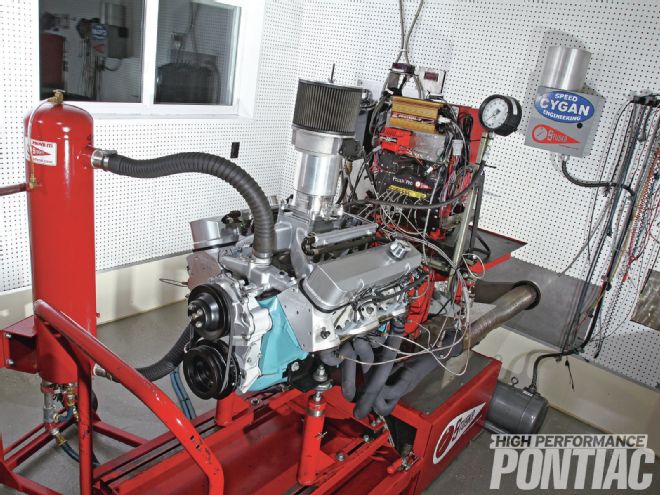
Modern engine-management systems are being installed in traditional Pontiacs more today than ever before. The desire for more efficient power production, better fuel mileage, improved driveability, and of course, bragging rights are the main reasons. Following that trend, Cygan Speed Engineering has moved into EFI installations using the BigStuff3 GEN3 Pro SEFI (Sequential Electronic Fuel Injection) system.
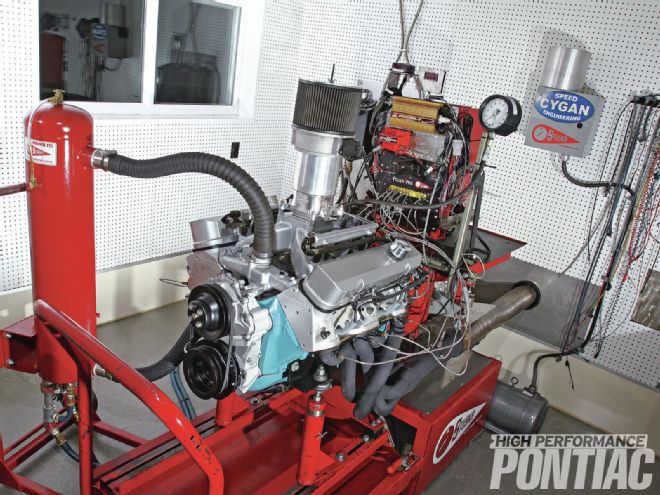
Having just finished a build on a 468-stroker engine for customer Jeff Hopper from Michigan, we dropped in on Gary Cygan’s Renfrew, Pennsylvania, shop to see how much power the combo produces on his Stuska dyno and watch him tune it via laptop for more. Gary tells HPP, “Jeff wanted a 600-horse, pump-gas engine that was docile enough for easy street driving, so I decided on the SEFI, aluminum heads with SD Performance’s chamber modification, a very streetable 10.67:1 compression ratio, and a hydraulic roller cam that’s not too aggressive. Given the mild cam specs, I think the fuel injection and tuning added power over a carbureted combo.”
Cygan Speed Engineering is now a distributor/installer for the BigStuff3 system. Truth be told, Gary is so taken with the GEN3 and how it works, he told HPP he would rather do EFI installations and dyno tuning on existing engines than build complete engines.
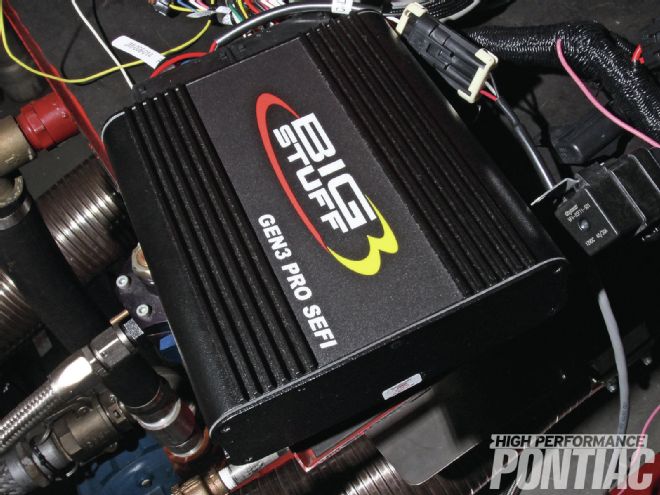 1 The BigStuff3 Gen3 Pro SEFI system (PN BS3-004-002) is delivered with a powdercoated aluminum Engine Control Unit (ECU), main wire harness, injector harness, wide-band oxygen sensor, and a communication cable. This particular part number also adds in DAI (internal data logging).
1 The BigStuff3 Gen3 Pro SEFI system (PN BS3-004-002) is delivered with a powdercoated aluminum Engine Control Unit (ECU), main wire harness, injector harness, wide-band oxygen sensor, and a communication cable. This particular part number also adds in DAI (internal data logging).
BigStuff3 is the brainchild of John Meaney and his brothers, Leo and Joe. John created the DFI system sold through ACCEL, and also developed the FAST standalone system. In 2003, he and his brothers formed BigStuff3 to “focus on the design, manufacture, and marketing of state-of-the-art electronic engine and powertrain controllers for the performance aftermarket,” says the company mission statement. The result thus far is the development of the GEN1 and GEN3 systems.
The main features of the GEN3 Sequential Electronic Fuel (SEFI) system are wide-band oxygen (WBO2) air/fuel ratio control, injector phasing, and individual cylinder fuel and spark compensation, but there are many more. (See the sidebar for details.) BigStuff3 provides the electronics, wiring, and software for the system, but not the hardware. The throttle body, intake, fuel rails, injectors, fuel regulator, ignition system, and MAP sensor are chosen and sourced by the dealer/installer.
Once Gary assembled the engine and installed the SEFI system, certain values had to be input in the computer during the Main Configuration setup so it knows what engine it’s dealing with. Interface between a PC, the engine, and the GEN3 ECU is via BigComm software, which contains the tables required to calibrate the system.
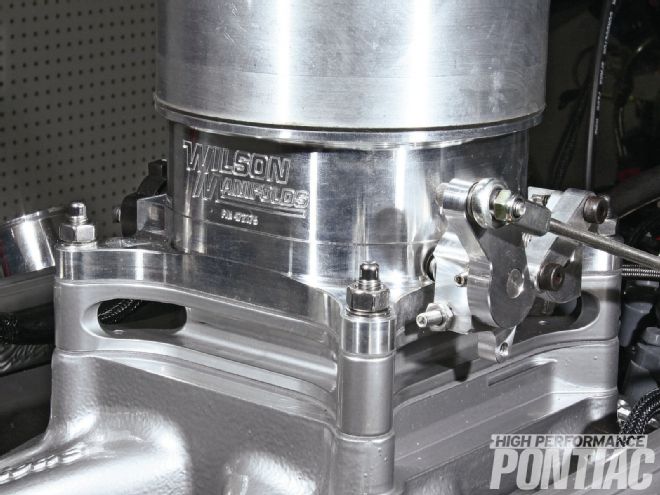 2 Perched atop a Wilson Manifolds 1-inch open spacer—which Gary says, “adds some more plenum area, but still maintains hood clearance”—is a Wilson High Flow (PN 472175) throttle body that’s CNC- machined from 6061-T6 aluminum with the goals of “maximum flow per-square-inch of cross-sectional area” and reduced mass in mind. It uses 1-to-1 linkage, unlike a typical four-barrel carb.
2 Perched atop a Wilson Manifolds 1-inch open spacer—which Gary says, “adds some more plenum area, but still maintains hood clearance”—is a Wilson High Flow (PN 472175) throttle body that’s CNC- machined from 6061-T6 aluminum with the goals of “maximum flow per-square-inch of cross-sectional area” and reduced mass in mind. It uses 1-to-1 linkage, unlike a typical four-barrel carb.
Before the tuning can begin, Gary has to first dial-in the crank trigger to the software. With the engine off, he sets the crank trigger for 50 degrees before TDC. It’s important because it gives 5 degrees of time lag to cover the ECU to respond at the 50-degree reference angle with a max of 45-degrees timing. The engine will not be run at 50 degrees timing—the timing will be controlled by the ECU. He then dials in 30 degrees timing (as an example) via the ECU, so he can check it at the balancer with a timing light and compare that with the reading the software is providing on the PC’s screen. If they don’t match but are fairly close, fine correction can be made in the software.
Prior to tuning, Gary also has to select the type of Throttle Position Sensor (TPS) being used to output the throttle angle to the ECU. (The GM TPS is 0.5V to 4.5V for 0- to 100-percent opening.)
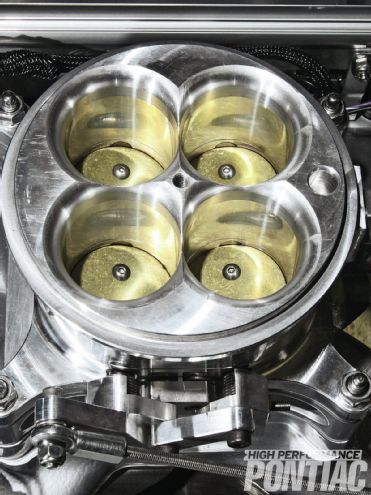 3 It flows 1,136 cfm, has tapered and radiused throttle bores, throttle shafts with less cross-sectional area to increase airflow, and brass throttle blades to limit vibration and thermal expansion. The blades open inward, Wilson says, to eliminate their part-throttle directional influence that can cause poor air distribution. They are installed with aircraft-quality fasteners with Loctite and are peened.
3 It flows 1,136 cfm, has tapered and radiused throttle bores, throttle shafts with less cross-sectional area to increase airflow, and brass throttle blades to limit vibration and thermal expansion. The blades open inward, Wilson says, to eliminate their part-throttle directional influence that can cause poor air distribution. They are installed with aircraft-quality fasteners with Loctite and are peened.
The system can be tuned in a speed density (engine speed and engine load) or Alpha N (throttle angle and engine speed) algorithm. Though most engine applications will use the speed-density control algorithm, the instructions indicate that for engines with cam duration over 260 degrees at 0.050, the Alpha N mode should be employed due to lack of engine vacuum with the higher overlap cam.
Despite the fact that this engine uses a 245-degree duration at 0.050 cam, Gary said, “The engine was not getting enough vacuum at different points, so I chose to use Alpha N over the speed density tuning.” (Had speed density been used, a manifold absolute pressure [MAP] sensor would be required and its setting also would have to be input. A one-bar MAP sensor is used for normally aspirated engines—two, three, four, or five-bar sensors are used for forced-induction engines, and the number is increased based on boost pressure.)
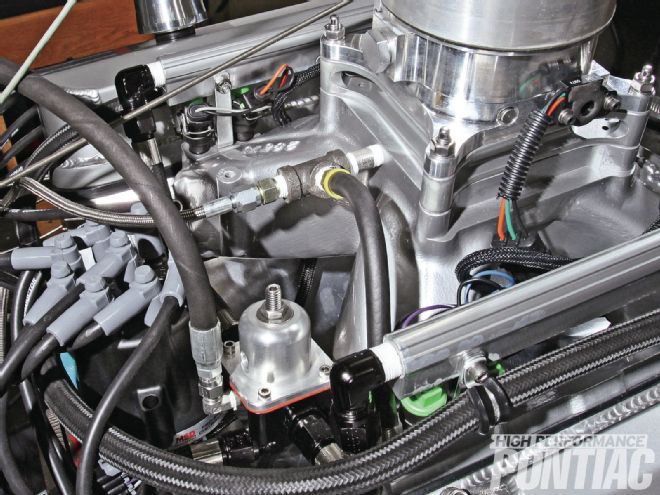 7 …wired to the MSD Pro-Billet distributor (PN 8563), which has its advance locked out since the ECU now makes the timing decisions. Also shown is the Weldon fuel regulator, (PN A2040) at the back of the fuel rail, which is set to 65 psi. Gary says, “The higher pressure provides more fuel more quickly, which allows me to reduce the injector phase angle and get the desired amount of fuel at the most opportune time.” The FAST throttle-position sensor is shown on the side of the throttle body.
7 …wired to the MSD Pro-Billet distributor (PN 8563), which has its advance locked out since the ECU now makes the timing decisions. Also shown is the Weldon fuel regulator, (PN A2040) at the back of the fuel rail, which is set to 65 psi. Gary says, “The higher pressure provides more fuel more quickly, which allows me to reduce the injector phase angle and get the desired amount of fuel at the most opportune time.” The FAST throttle-position sensor is shown on the side of the throttle body.
Engine tuning is accomplished via various tuning tables. The Fuel Table allows Gary to input desired volumetric efficiency (VE) values for 16 engine speed (rpm) and 16 load (MAP or TPS) combinations, and the Spark Table allows the same number of inputs, but uses actual timing values. Gary can input desired air/fuel ratios for 16 engine speed (rpm) and 8 load (MAP or TPS) combinations in the Air/Fuel Ratio Table. The X-axis represents engine rpm and the Y-axis represents engine load in each of the tables and both are configurable. During engine operation, a “real-time ellipse” travels across each of the cells in the table relative to the current rpm and load “operating point.”
Since Gary is tuning in Alpha N mode, the Air Temperature Correction Table and Water Temperature Correction Table will also be referenced, as the ECU uses input from them for air-temperature and water-temperature compensation. He tuned in closed loop so that the oxygen sensor feedback could be used to make sure the air/fuel ratio that he dialed in was achieved, by providing small corrections as needed.
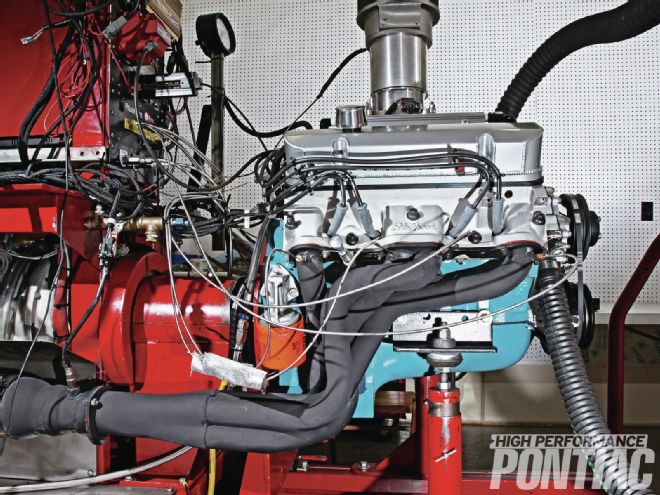 8 The headers used for dyno testing are Hooker Super Comp four-tubes with 2-inch primaries and 3.5-inch collectors. Note the EGT probes. Gary says, “Through my experience on EFI engines, the EGTs are much more equal from cylinder to cylinder than on even a finely tuned carbureted engine.”
8 The headers used for dyno testing are Hooker Super Comp four-tubes with 2-inch primaries and 3.5-inch collectors. Note the EGT probes. Gary says, “Through my experience on EFI engines, the EGTs are much more equal from cylinder to cylinder than on even a finely tuned carbureted engine.”
To learn more about this engine combo and illustrate how Gary tuned it, refer to the photos and captions. Though in this session the engine was tuned for full-throttle performance, it’s important to state that with SEFI, the engine can be more finely tuned for all throttle positions and driving conditions than when using a carburetor. It can be tweaked in many other operational aspects as well, however, we limit our discussion to specific power tuning for this story.
Contact Cygan Speed Engineering for pricing on an SEFI system that’s custom-built for your application. Installation and tuning are available at additional cost.
Engine displacement: 468ci
Bore/stroke: 4.190/4.250-in
Block/crank combo: 400/Eagle cast 4.250
Bore/stroke ratio: 0.986:1
Rod/stroke ratio: 1.6:1
Bottom End
Block: ’75, Cast No. 481988
Preparation: Square-decked, bored, and honed to 4.190-in with torque plate, installed 4 Program Engineering four-bolt main caps, line-honed, rotating assembly balanced
Deck height: 10.215-in
Crank: Eagle cast 4.250-in
Preparation: Balanced, oil holes chamfered
Balancer: Cygan Speed Engineering-designed ATI Super Damper with crank trigger magnets in the shell
Rods: Eagle forged-steel H-beam 6.800-in
Bearings: Clevite
Pistons: Ross forged flat-top with 20cc dish
Preparation: Deburr all edges
Piston to deck height: 0
Piston pins: Ross 0.990-in
Method used to retain piston pins in pistons: Dual spiral locks
Rings: Total Seal File to Fit, 1⁄16, 1⁄16, 3⁄16-in
Preparation: Deburr edges
Hardware: ARP 2000 rod bolts, ARP main and head studs
Balancing specs: Whole assembly balance 2,161 grams bobweight
Oiling System
Windage tray: GM full-length
Oil pan: Canton 452
Oil pump: Mellings 54F
Preparation: Disassemble pump, deburr, open oil passage
Heads
Type: Edelbrock round-port
Mods: .Heart-shaped combustion chamber, CNC- ported by Dave Bisschop at SD Performance
Combustion chamber volume: 70 cc
Maximum flow at 28-in of pressure
Intake: 340 cfm at 0.800-in
Exhaust: 254 cfm at 0.800-in
Compression ratio: 10.67:1
Valves: Ferrea Stainless Steel
Intake size: 2.20/1.74-in
Retainers: Tool Steel
Keepers: 10-deg
Valve guides: Bronze
Valve seals: Viton
Rocker studs: ARP
Rocker arms: Scorpion roller 1.65:1
Pushrods: Trick Flow 0.080-in heat-treated chrome-moly
Diameter: 5⁄16-in
Length: 8.850-in
Cam
Brand: Bullet hydraulic roller
Duration at 0.050: 245/249-deg
Lift: 0.630/0.630-in
Centerline: 108-deg
Lobe separation angle: 112-deg
Installed position: 107.5-deg
Lifters: Bullet hydraulic roller
Valvesprings: Crane 99893 double
Seat pressure: 160 lb/in
Open pressure: 400 lb/in
Timing chain: Nine-keyway, double-roller Butler Performance JPP-5614
EFI
Throttle body: Wilson 4150
Fuel injectors: Fast 42-lb/hr
Fuel rails: Edelbrock
Intake manifold: Victor 29575
Ignition
Brand: MSD Distributor 8563
Amplifier: MSD Digital 7 (Dyno)
Coil brand: MSD (Dyno)
Wires: MSD 8.5 mm
Plugs: NGK
Gaskets
Brand: Cometic head gaskets